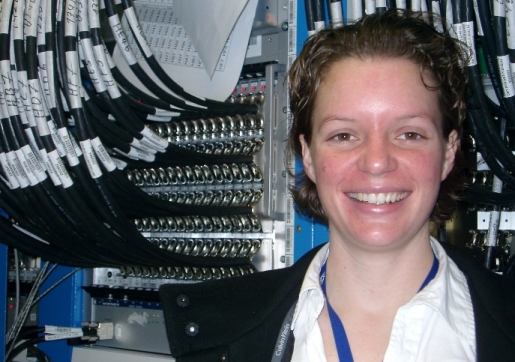Monica Dunford
17 March 2008 | By

Anyone working on the ATLAS experiment right now will agree that it is more than a full-time job. But Monica Dunford is not your average woman. On top of working on the Tile Calorimeter, helping to commission the Level-one Trigger, and coordinating Tile Cal’s operation running, she somehow finds the time and energy to row, ski, run marathons, and tell the world about life here at ATLAS.
After gaining a BS in Physics from the University of California, Irvine, Monica studied for her PhD at the University of Pennsylvania, Philadelphia. For this, she was based two kilometres underground at the Sudbury Neutrino Observatory (SNO) in Ontario, northern Canada. In November 2006, she made the move from studying extra-terrestrial particles to collider physics, joining ATLAS as an affiliate of the University of Chicago.
“I specifically wanted to work on ATLAS, and I knew that 2007-2008 would be the time to work on it. It was a chance of a lifetime,” she says. “I had the opportunity to stay in Chicago or come here. But I love to be right where the action is, so here I am!”
Through her blog at http://uslhc.us/blogs, Monica is one of the more public faces of the ATLAS Experiment. She has been blogging there since the site launched seven months ago, but she found it nerve-wracking to begin with: “When you’re having a one-on-one conversation with someone, you get verbal and visual feedback about how that person is responding to you. But when you’re blogging, putting up your comments, thoughts, and ideas… you have no idea if people are reading and thinking ‘what an idiot this woman is’!”
Having previously been a fan of the Quantum Diaries blogs, Monica started out with a clear idea of the tone she wanted her blog to take; it is geared more towards a public audience than a technical one. After seven months, she feels she has relaxed into her own style, and tries to post at least once a week. Arguably a relief from the regimented nature of her physics work, she finds it to be an excellent creative outlet, and especially enjoys thinking up interesting analogies which make her subject more obviously relevant to everyday life.
“What we do here is tangible,” she explains, “but because we spend so much time speaking the lingo with people here, we often forget how to explain it. I think outsiders fundamentally do understand, but you need to cut out the technical terms in order to communicate effectively.”
“Also, there’s a difference between physics and doing physics,” she adds. “Physics involves looking for the Higgs, for example. But doing physics often involves things like dealing with the frustrations of recovering from a power cut.”
Resilience is certainly one of Monica’s strongest qualities; a fact which manifests itself in her love of endurance sports. She has run several marathons as well as shorter races, and been cross-country skiing almost every weekend this season. But perhaps her greatest achievement is completing the Tour du Lac last year. “It was the coolest thing I’ve ever done,” she says of the rowing race around Lake Geneva, which she did as part of a five-person team. Her team was placed first in their category, and finished within 15.5 hours.
“If you gave me a choice between a hundred metre sprint, and the row round the lake, I’d go for the row every time,” she says, contemplating exactly what it is that drives her to push at the limits of her endurance. “I like the feeling of really being in a stride. After a while you’re just in a rhythm. For the final two hours of the Tour du Lac, there was just complete silence; all you could hear was the sound of the blades, and everyone was one hundred per cent focussed. We’d been on the water thirteen hours by that point, and we were just five minds utterly focussed on getting to the finish.”
Asked whether she can draw any parallels between the teamwork and endurance aspects of her athletic pursuits and physics at ATLAS, Monica doesn’t hesitate: “Oh absolutely! Rowing is the ultimate team sport. You can’t do your own thing. Even if you feel that your rowing style is stronger, you have to stay with the person in front; otherwise the boat just won’t go. And people who understand that the whole is greater than the individual are essential to an operation like ATLAS,” she explains. “As for endurance… it’s a high-stress time at the moment. But people here never lose their cool. That’s like endurance running. Sometimes you just want to go home, but you just have to keep putting one foot in front of the other until it works.”
Radiant, tenacious, and living her life to the max; ATLAS is certainly lucky to have Monica as part of the team.



